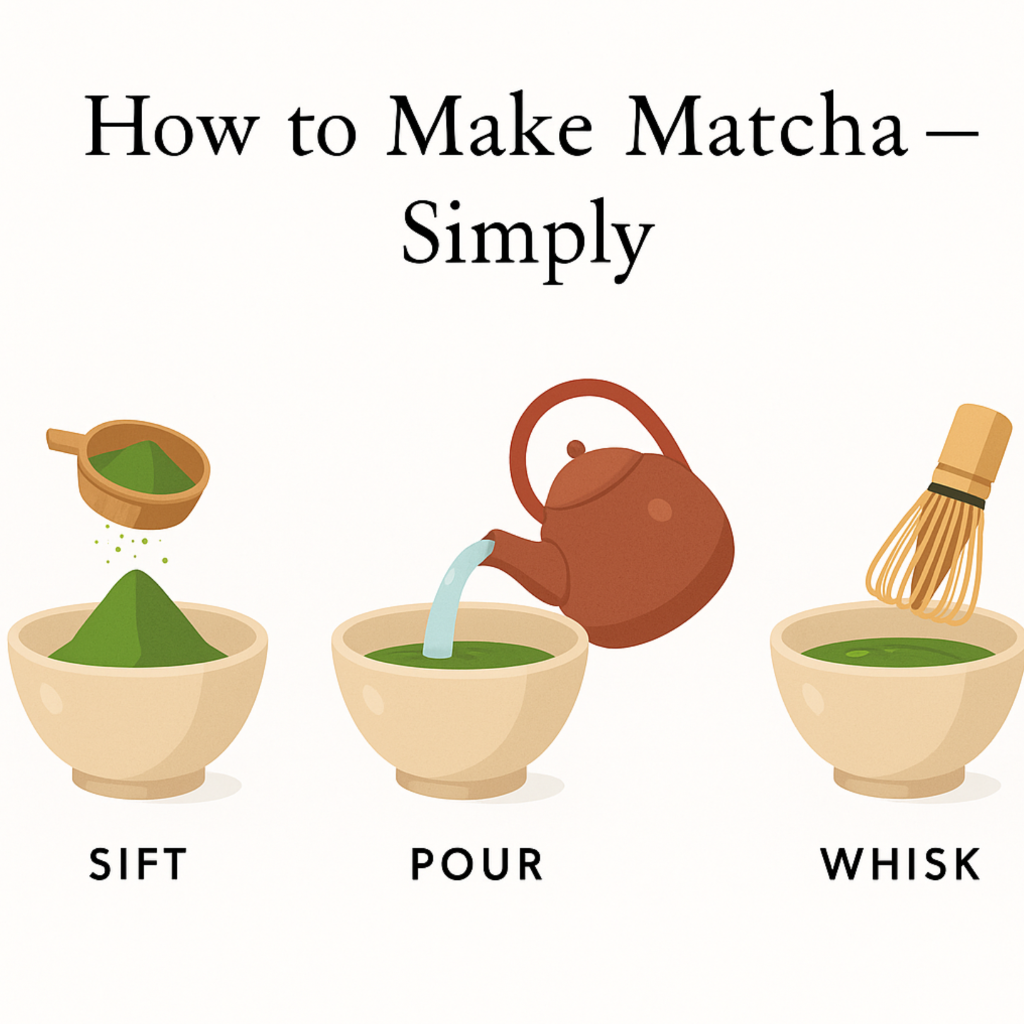
What Is Matcha — And How I Finally Got It Right
Share
Starting with matcha can feel confusing — all the grades, tools, and unfamiliar terms.
But you don’t need to get it perfect. You just need to start.
We’re here to help you make your first cup simple, calm, and good.
✅ Why You Can Trust Us
We’ve worked with artisanal tea farmers in Japan for over 7 years
Our matcha is always ceremonial-grade and single-origin
We’ve helped over 8,000 customers create a mindful matcha habit
Every product is tested, tasted, and used by our own team — we only sell what we drink
Table of Content
Matcha 101
1.My First Terrible Cup of Matcha
1. My First Terrible Cup of Matcha
I remember the cup.
White porcelain. A little chipped at the rim.
I had just moved into my first apartment alone, and the kitchen still smelled like cardboard.
It was a Saturday morning — cold, quiet, nothing urgent on the calendar.
I wanted to try something new. I had seen the word "matcha" floating around Instagram.
So I bought a tin online. The label said premium. That was good enough for me.
I boiled the water. Scooped in a full tablespoon. Stirred with a metal spoon.
The powder clumped and refused to dissolve.
The color was more khaki than green.
Still, I took a sip.
It tasted like… swamp.
Bitter. Sharp. Somehow both dusty and sour.

I remember thinking:
“Maybe I just don’t like matcha.”
But here’s what I didn’t know:
That boiling water burns matcha.
That “premium” means nothing without knowing the grade.
That a spoon won’t blend matcha, only frustrate it.
That the bitterness wasn’t a feature — it was a failure of technique.
So I gave up. Closed the tin.
Pushed it to the back of the cupboard.
And forgot about it.
For two months.
Must have to begin your tea ritual
2. What Matcha Actually Is
Matcha isn’t “just powdered green tea.”
It’s a whole system. A method. A choice to slow down.
Matcha comes from the *Camellia sinensis* plant — just like black tea, oolong, and sencha. What makes it different isn’t the plant. It’s the process.
The leaves are grown under shade for about three weeks before harvest. That shade changes everything.
It makes the leaves produce more chlorophyll. It boosts amino acids like L-theanine. It turns the tea a deeper green — not just in color, but in taste.
After picking, the leaves are steamed, dried, and deveined. Then they’re ground slowly — on granite stones — into a fine powder called **matcha**.
That’s what ends up in your cup. Not a leaf soaked in water. The entire leaf itself — dissolved, whisked, alive.
That’s why it hits different. Why you don’t just drink it — you *feel* it.

“When you drink tea, just drink tea.”
— D.T. Suzuki
3. Ceremonial vs. Culinary Grade
The second time I bought matcha, I thought I was smarter.
The tin looked nicer. It had a gold label. The website said “premium ceremonial culinary grade” — whatever that meant. I didn’t ask. I just paid.
When it arrived, I opened the lid and frowned. It smelled sharp. The green wasn’t bright — it was dull, like dried moss. I tried it anyway. It was better than the first time. But not by much.
That’s when I learned: **not all matcha is meant to be drunk straight.**
---

🎯 The Difference
**Culinary grade matcha** is made from older leaves. It’s more bitter. Less vibrant. Cheaper to produce. It’s not bad — it just has a job: to mix into things. Smoothies. Cookies. Lattes with sugar.
**Ceremonial grade matcha** is made from the youngest spring leaves. It’s stone-ground slowly. It’s meant to stand alone. No milk. No sugar. Just matcha and water. It’s bright, smooth, almost sweet, with a soft umami taste.
☕ So which one do you need?
Ask yourself: **Are you drinking this plain?
If yes → choose ceremonial.
If you’re blending it into things → culinary is fine.
But don’t expect a $7 matcha to taste like a quiet sunrise. That’s not its job.
What I Wish I Had Bought First
4. How to Spot Good Matcha
After a few more disappointments, I started reading labels. Then I started trusting my eyes.
Good matcha doesn’t hide. It shows up the moment you open the tin.

👀 What to look for:
- The **color** should be bright — not neon, but alive. Think spring leaves, not dried grass. - The **texture** should be soft and fine, not gritty or clumpy. - The **smell** should be fresh, grassy, even a little sweet — not fishy, musty, or sour.
---
I once bought a tin that smelled like wet cardboard. Another one had bright packaging, but inside: a dull, army-green powder that tasted like burnt kale. Both were labeled “ceremonial.” Both were wrong.
That’s when I realized: the word *ceremonial* means nothing without trust. Matcha doesn’t lie, but marketing sometimes does.
---
🧪 Here’s how I check now:
- I look at the color in natural light. - I smell it right after opening. - I check how easily it blends into water — does it float? Sink? Clump?
And most of all: I taste.
Real matcha feels gentle, full, round. Even when it’s grassy, it doesn’t bite. Even when it’s rich, it doesn’t burn.
That’s the moment you know: You didn’t make a mistake this time.

“True beauty is not to be found in perfection, but in the traces of the real.”
— Okakura Kakuzō
5. How to Make Matcha
Simply The first time I saw someone whisk matcha properly, I froze. It wasn’t fancy. It wasn’t slow. It was *intentional*. They scooped. They poured. They whisked like they meant it — fast, loose, like writing the letter “M” in water. Sixty seconds later, the foam was perfect. --- I realized then: Matcha doesn’t ask for ceremony. It asks for attention.
Here’s the way I make it now:
1. **Sift** 1 teaspoon of matcha into a bowl. (If you don’t sift, you’ll get clumps. You’ll think you hate matcha again.)
2. **Add** 2 oz of hot water (about 160°F / 70°C). (Boiling water burns it. This is tea, not soup.)
3. **Whisk** briskly — zigzag motion, not in a circle — until bubbles form on top. (That foam? It’s not just pretty. It means you did it right.)




6. Final Thoughts
I don’t sell matcha because it’s trendy.
I sell it because I’ve made every mistake you just read.
I’ve burned it. I’ve overpaid for the wrong grade. I’ve forced down bitter lattes and wondered if matcha just wasn’t for me.
But I stayed curious.
I learned. I started working directly with tea farmers in Japan — not factories, not warehouses. Real people, real leaves, real weather in real soil.
Now, every matcha I offer starts with a question I ask myself: “Would I choose this for myself, day after day?”

Conclusion
Matcha isn’t a performance. It isn’t perfection.
It’s a small green moment — where your hands slow down, your breath evens out, and something quiet inside you says: *“This is enough.”*
That’s all it needs to be.
So if your first cup was terrible — welcome. You’re in the right place.
Your matcha journey starts here.
If you want to buy yoga mats or books for beginners, you can check out more on our store

The Author: Chang Liu
I’ve worked in food and beverage for over 25 years — sourcing, tasting, building. But matcha is different. It’s not just a drink. For me, it’s a quiet companion. A way to return. A soft light on the path of practice, one cup at a time.
Products Featured In This Blog
Frequently Asked Questions
1. Why did my matcha taste bitter?
Usually because the water was too hot, or the matcha quality was too low.
Try using water around 160°F (70°C), and whisking well with a bamboo chasen. Also, ceremonial-grade matcha is much smoother than culinary grade.
2. What’s the difference between ceremonial and culinary matcha?
Ceremonial matcha is made from the youngest, most tender leaves — it’s smoother, sweeter, and designed to be drunk plain.
Culinary matcha is stronger and more bitter, meant for mixing into lattes, smoothies, and baking.
3. Can I make matcha without special tools?
Yes. You can use a milk frother or even shake it in a jar.
But for best results — and better foam — a bamboo whisk (chasen) makes a real difference.
4. How do I know if my matcha is good?
Look for vibrant green color, a fresh grassy smell, and a smooth mouthfeel.
Avoid dull, brownish, or yellow-green powders. If it smells fishy or tastes sharp, it’s likely low-grade or old.
5. Does matcha have more caffeine than coffee?
Matcha has less caffeine than coffee, but it releases slower — giving you calm focus instead of a spike-crash cycle.
L-theanine in matcha also promotes relaxation.



